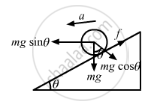Advertisements
Advertisements
प्रश्न
A hollow sphere is released from the top of an inclined plane of inclination θ. (a) What should be the minimum coefficient of friction between the sphere and the plane to prevent sliding? (b) Find the kinetic energy of the ball as it moves down a length l on the incline if the friction coefficient is half the value calculated in part (a).
उत्तर
It is given that a hollow sphere is released from the top of an inclined plane of inclination θ.
(a) To prevent sliding, the body will make only perfect rolling. In this condition, we have
\[mgl \sin \theta - f = ma............(1)\]
\[f \times R = \left( \frac{2}{3} \right) m R^2 \times \left( \frac{a}{R} \right)\]
\[ \Rightarrow f = \frac{2}{3} ma...........(2)\]
On putting this value in the equation (1), we get
\[mg \sin \theta - \frac{2}{3} ma = ma\]
\[\Rightarrow a = \frac{3}{5} g \sin \theta\]
From equation (1), we have
\[mg \sin \theta - f = \frac{3}{5} mg \sin \theta\]
\[ \Rightarrow f = \frac{2}{5} mg \sin \theta\]
\[ \Rightarrow \mu mg \cos \theta = \frac{2}{5} mg \sin\theta\]
\[ \Rightarrow \mu = \frac{2}{5} \tan \theta\]
(b)
\[\left( \frac{1}{5} \right) \tan \theta \left( mg \cos \theta \right) R = \frac{2}{3} m R^2 \alpha\]
\[ \Rightarrow \alpha = \frac{3}{10} \left( \frac{g \sin \theta}{R} \right)\]
\[a_c = g \sin \theta - \left( \frac{g}{5} \right) \sin \theta\]
\[ = \left( \frac{4}{5} \right) g \sin \theta\]
\[ \Rightarrow t^2 = \frac{2l}{a_c}\]
\[= 2l \left( 4g\frac{\sin \theta}{5} \right) \left( \frac{5}{2g \sin \theta} \right)\]
\[\therefore \omega = at \]
\[ K . E . = \frac{1}{2} m \nu^2 + \frac{1}{2} I \omega^2 \]
\[ = \frac{1}{2} m \left( 2al \right) + \frac{1}{2} l \left( a^2 t^2 \right)\]
\[ = \frac{1}{2} m \left( 4g \frac{\sin \theta}{5} \right) \times 2 \times l + \frac{1}{2} \times \frac{2}{3} m R^2 \times \frac{9}{100}\]
\[ = \left( \frac{\sin^2 \theta}{R} \right) \times \left( \frac{5L}{2g \sin \theta} \right)\]
\[ = 4 mgl \frac{\sin \theta}{5} + 3 mgl \frac{\sin \theta}{40}\]
\[ = \frac{7}{8} mgl \sin \theta\]

APPEARS IN
संबंधित प्रश्न
Read each statement below carefully, and state, with reasons, if it is true or false;
The instantaneous speed of the point of contact during rolling is zero.
If a rigid body of radius ‘R’ starts from rest and rolls down an inclined plane of inclination
‘θ’ then linear acceleration of body rolling down the plane is _______.
Can an object be in pure translation as well as in pure rotation?
Two uniform solid spheres having unequal masses and unequal radii are released from rest from the same height on a rough incline. If the spheres roll without slipping, ___________ .
A sphere cannot roll on
A sphere can roll on a surface inclined at an angle θ if the friction coefficient is more than \[\frac{2}{7}g \tan\theta.\] Suppose the friction coefficient is \[\frac{1}{7}g\ tan\theta.\] If a sphere is released from rest on the incline, _____________ .
A solid sphere of mass 0⋅50 kg is kept on a horizontal surface. The coefficient of static friction between the surfaces in contact is 2/7. What maximum force can be applied at the highest point in the horizontal direction so that the sphere does not slip on the surface?
Discuss the interlink between translational, rotational and total kinetic energies of a rigid object rolls without slipping.
Answer in Brief:
A rigid object is rolling down an inclined plane derive the expression for the acceleration along the track and the speed after falling through a certain vertical distance.
A pendulum consisting of a massless string of length 20 cm and a tiny bob of mass 100 g is set up as a conical pendulum. Its bob now performs 75 rpm. Calculate kinetic energy and increase in the gravitational potential energy of the bob. (Use π2 = 10)
What is the condition for pure rolling?
A uniform disc of mass 100g has a diameter of 10 cm. Calculate the total energy of the disc when rolling along with a horizontal table with a velocity of 20 cms-1. (take the surface of the table as reference)
A solid sphere rolls down from top of inclined plane, 7m high, without slipping. Its linear speed at the foot of plane is ______. (g = 10 m/s2)
A man is supported on a frictionless horizontal surface. It is attached to a string and rotates about a fixed centre at an angular velocity `omega`. The tension in the strings is F. If the length of string and angular velocity are doubled, the tension in string is now ____________.
A solid spherical ball rolls on an inclined plane without slipping. The ratio of rotational energy and total energy is ______.
A circular disc reaches from top to bottom of an inclined plane of length 'L'. When it slips down the plane, it takes time ' t1'. when it rolls down the plane, it takes time t2. The value of `t_2/t_1` is `sqrt(3/x)`. The value of x will be ______.
Solid spherical ball is rolling on a frictionless horizontal plane surface about is axis of symmetry. The ratio of rotational kinetic energy of the ball to its total kinetic energy is ______.
The kinetic energy and angular momentum of a body rotating with constant angular velocity are E and L. What does `(2E)/L` represent?
A disc of mass 4 kg rolls on a horizontal surface. If its linear speed is 3 m/ s, what is its total kinetic energy?
